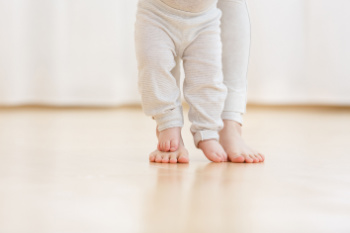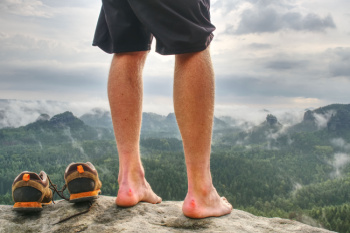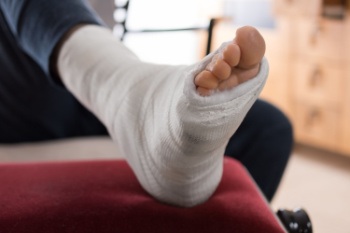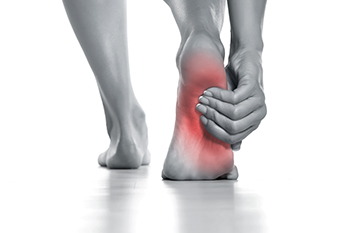
Cedarhurst (516) 374-3668
Franklin Square (516) 775-8440

Cedarhurst (516) 374-3668
Franklin Square (516) 775-8440

Children are often active and growing rapidly, which makes them susceptible to a variety of foot problems. Some of the most frequently seen issues include flat feet, plantar warts, ingrown toenails, and Sever’s disease. Flat feet occur when the arches do not develop properly, leading to discomfort or pain, especially during physical activities. Although many children outgrow this condition, some may need supportive footwear or orthotics. Plantar warts, caused by a viral infection, often develop on the soles of the feet and can be painful. These warts are common in children who frequently walk barefoot in public places like pools or locker rooms. Ingrown toenails, where the nail grows into the skin, can cause significant pain and even infection. This is often due to improper nail trimming or wearing tight shoes. Sever’s disease is a common cause of heel pain in growing children, resulting from inflammation of the growth plate in the heel. Rest and proper footwear are key to managing this condition. If your child suffers from a foot problem, it is suggested that you schedule an appointment with a podiatrist, a specialist who treats various conditions related to the feet and ankles.
Making sure that your children maintain good foot health is very important as they grow. If you have any questions, contact Robert Stein, DPM of South Shore Foot Care. Our doctor can provide the care you need to keep you pain-free and on your feet.
Keeping Children's Feet Healthy
Having healthy feet during childhood can help prevent medical problems later in life, namely in the back and legs. As children grow, their feet require different types of care. Here are some things to consider...
Although babies do not walk yet, it is still very important to take care of their feet.
Avoid putting tight shoes or socks on his or her feet.
Allow the baby to stretch and kick his or her feet to feel comfortable.
As a toddler, kids are now on the move and begin to develop differently. At this age, toddlers are getting a feel for walking, so don’t be alarmed if your toddler is unsteady or ‘walks funny’.
As your child gets older, it is important to teach them how to take care of their feet.
Show them proper hygiene to prevent infections such as fungus.
Be watchful for any pain or injury.
Have all injuries checked by a doctor as soon as possible.
Comfortable, protective shoes should always be worn, especially at play.
If you have any questions please feel free to contact our offices located in Cedarhurst and Franklin Square, NY . We offer the newest diagnostic and treatment technologies for all your foot and ankle needs.

Blisters while hiking often result from friction between the skin and footwear, worsened by moisture and heat. Causes include wearing ill-fitting shoes, worn-out footwear, or improper socks that do not wick moisture effectively. Extended hikes and rough terrain can also contribute to blister formation. To prevent blisters, ensure you wear well-fitting shoes that have been properly broken in before hitting the trails. Opt for moisture-wicking socks made of synthetic fibers or merino wool, and consider using blister prevention tape on high-friction areas. Keeping your feet dry is important, so change wet socks promptly and use footpowder to reduce moisture. Regularly check your feet during hikes and address any signs of discomfort early. If you have developed a painful blister, or have recurring blisters from hiking, it is suggested that you schedule an appointment with a podiatrist who can offer you relief methods.
Blisters are prone to making everyday activities extremely uncomfortable. If your feet are hurting, contact Robert Stein, DPM of South Shore Foot Care. Our doctor can provide the care you need to keep you pain-free and on your feet.
Foot Blisters
Foot blisters develop as a result of constantly wearing tight or ill-fitting footwear. This happens due to the constant rubbing from the shoe, which can often lead to pain.
What Are Foot Blisters?
A foot blister is a small fluid-filled pocket that forms on the upper-most layer of the skin. Blisters are filled with clear fluid and can lead to blood drainage or pus if the area becomes infected.
How Do Blisters Form?
Blisters on the feet are often the result of constant friction of skin and material, usually by shoe rubbing. Walking in sandals, boots, or shoes that don’t fit properly for long periods of time can result in a blister. Having consistent foot moisture and humidity can easily lead to blister formation.
Prevention & Treatment
It is important to properly care for the affected area in order to prevent infection and ease the pain. Do not lance the blister and use a Band-Aid to provide pain relief. Also, be sure to keep your feet dry and wear proper fitting shoes. If you see blood or pus in a blister, seek assistance from a podiatrist.
If you have any questions, please feel free to contact our offices located in Cedarhurst and Franklin Square, NY . We offer the newest diagnostic and treatment technologies for all your foot care needs.

Gait retraining is an increasingly popular intervention for distance runners experiencing pain or injury due to improper running mechanics. This specialized training focuses on altering a runner’s movement patterns to reduce stress on tissues and redistribute forces more evenly across joints. Common techniques include visual feedback, step rate manipulation, and foot strike adjustments. Each method of gait retraining aims to correct specific biomechanical issues that contribute to running-related injuries. While gait retraining has proved effective, it is essential to tailor the approach to the individual’s needs and abilities. A podiatrist can help a runner make an informed decision about which gait retraining methods will be most beneficial. Given the complexity of running mechanics, a thorough evaluation by a podiatrist ensures that the method chosen will address the root cause of pain without introducing new issues. If you experience foot pain after long distance running, it is suggested that you schedule an appointment with a podiatrist to determine if gait retraining is needed.
If you have any concerns about your feet, contact Robert Stein, DPM from South Shore Foot Care. Our doctor can provide the care you need to keep you pain-free and on your feet.
Biomechanics in Podiatry
Podiatric biomechanics is a particular sector of specialty podiatry with licensed practitioners who are trained to diagnose and treat conditions affecting the foot, ankle and lower leg. Biomechanics deals with the forces that act against the body, causing an interference with the biological structures. It focuses on the movement of the ankle, the foot and the forces that interact with them.
A History of Biomechanics
Modern technological improvements are based on past theories and therapeutic processes that provide a better understanding of podiatric concepts for biomechanics. Computers can provide accurate information about the forces and patterns of the feet and lower legs.
Understanding biomechanics of the feet can help improve and eliminate pain, stopping further stress to the foot.
If you have any questions please feel free to contact our offices located in Cedarhurst and Franklin Square, NY . We offer the newest diagnostic and treatment technologies for all your foot and ankle needs.

A Lisfranc fracture is a serious injury involving the bones and joints in the midfoot. It specifically affects the Lisfranc joint complex, where the metatarsal bones connect with the bones of the midfoot. This type of fracture often results from a high-impact trauma or a severe twisting injury, such as those occurring in sports injuries or car accidents. Symptoms of a Lisfranc fracture can include intense pain in the midfoot, swelling, bruising, and difficulty bearing weight. The injury can sometimes be mistaken for less severe foot conditions, which underscores the importance of proper diagnosis. Immediate medical attention is vital for effective treatment, which may involve rest, immobilization, or surgical intervention depending on the severity. If you have a broken foot, it is suggested that you consult a podiatrist who can determine the type of fracture and offer treatment methods that are right for you.
A broken foot requires immediate medical attention and treatment. If you need your feet checked, contact Robert Stein, DPM from South Shore Foot Care. Our doctor can provide the care you need to keep you pain-free and on your feet.
Broken Foot Causes, Symptoms, and Treatment
A broken foot is caused by one of the bones in the foot typically breaking when bended, crushed, or stretched beyond its natural capabilities. Usually the location of the fracture indicates how the break occurred, whether it was through an object, fall, or any other type of injury.
Common Symptoms of Broken Feet:
Those that suspect they have a broken foot shoot seek urgent medical attention where a medical professional could diagnose the severity.
Treatment for broken bones varies depending on the cause, severity and location. Some will require the use of splints, casts or crutches while others could even involve surgery to repair the broken bones. Personal care includes the use of ice and keeping the foot stabilized and elevated.
If you have any questions please feel free to contact our offices located in Cedarhurst and Franklin Square, NY . We offer the newest diagnostic and treatment technologies for all your foot and ankle needs.

Millions of people in the United States experience chronic foot pain, which can interfere with daily activities. Common causes can include bunions, which are painful bumps at the base of the big toe caused by joint misalignment. This condition is often managed with wearing roomier shoes or, in severe cases, surgery. Fallen arches, resulting from a loss of tendon elasticity, can lead to pain in the arch, ankle, and leg. Typical treatment includes supportive insoles and certain stretching exercises. Hammertoes, where a toe bends abnormally and rubs against shoes, can cause discomfort that may be relieved by changes in footwear or undergoing surgery, if necessary. Ingrown toenails, frequently the result of improper nail trimming, can cause pain and swelling, often requiring professional care to prevent infection. Lastly, plantar fasciitis is a common cause of heel pain stemming from tiny tears in the foot's supporting tissue. Relief may be found from practicing specific stretches, wearing heel inserts and night splints. If you are experiencing any type of foot pain, it is suggested that you schedule an appointment with a podiatrist for a diagnosis and appropriate treatment solutions.
Foot Pain
Foot pain can be extremely painful and debilitating. If you have a foot pain, consult with Robert Stein, DPM from South Shore Foot Care. Our doctor will assess your condition and provide you with quality foot and ankle treatment.
Causes
Foot pain is a very broad condition that could be caused by one or more ailments. The most common include:
Diagnosis
To figure out the cause of foot pain, podiatrists utilize several different methods. This can range from simple visual inspections and sensation tests to X-rays and MRI scans. Prior medical history, family medical history, and any recent physical traumatic events will all be taken into consideration for a proper diagnosis.
Treatment
Treatment depends upon the cause of the foot pain. Whether it is resting, staying off the foot, or having surgery; podiatrists have a number of treatment options available for foot pain.
If you have any questions, please feel free to contact our offices located in Cedarhurst and Franklin Square, NY . We offer the newest diagnostic and treatment technologies for all your foot care needs.

Foot surgery to remove a corn is a common procedure aimed at alleviating pain and discomfort. A corn, which is a thickened area of skin usually caused by friction or pressure, can be effectively addressed through this surgical intervention. The procedure begins with a local anesthetic to numb the area, ensuring the patient feels no pain. The podiatric surgeon then makes a small incision to carefully remove the corn and any surrounding thickened skin. The underlying cause, such as wearing ill-fitting shoes or structural abnormalities, is often evaluated to prevent recurrence. Post-surgery, the area is dressed and a follow-up is scheduled to monitor healing and ensure no complications arise. If you have a painful corn on your foot that is causing pain and discomfort, it is suggested that you consult a podiatrist who can determine if surgical removal is right for you.
Foot surgery is sometimes necessary to treat a foot ailment. To learn more, contact Robert Stein, DPM of South Shore Foot Care. Our doctor will assist you with all of your foot and ankle needs.
When Is Surgery Necessary?
Foot and ankle surgery is generally reserved for cases in which less invasive, conservative procedures have failed to alleviate the problem. Some of the cases in which surgery may be necessary include:
What Types of Surgery Are There?
The type of surgery you receive will depend on the nature of the problem you have. Some of the possible surgeries include:
Benefits of Surgery
Although surgery is usually a last resort, it can provide more complete pain relief compared to non-surgical methods and may allow you to finally resume full activity.
Surgical techniques have also become increasingly sophisticated. Techniques like endoscopic surgery allow for smaller incisions and faster recovery times.
If you have any questions please feel free to contact our offices located in Cedarhurst and Franklin Square, NY . We offer the newest diagnostic and treatment technologies for all your foot and ankle needs.

Diabetic neuropathy is a serious complication of diabetes that results from nerve damage caused by prolonged high blood sugar and elevated blood fats. This condition often targets the nerves in the lower legs and feet, leading to what is known as peripheral neuropathy. Studies show that between one-third and one-half of people with diabetes will experience this condition. Diabetic neuropathy can bring on a range of uncomfortable symptoms, including numbness and weakness, burning, tingling, and pain in the lower limbs. Additionally, the diminished sensation can make you more susceptible to unnoticed wounds on your feet, which increases the risk of infections and complications. To manage diabetic neuropathy effectively, it is suggested you schedule an appointment with a podiatrist, ensuring that any potential issues are caught early and treated appropriately.
Neuropathy
Neuropathy can be a potentially serious condition, especially if it is left undiagnosed. If you have any concerns that you may be experiencing nerve loss in your feet, consult with Robert Stein, DPM from South Shore Foot Care. Our doctor will assess your condition and provide you with quality foot and ankle treatment for neuropathy.
What Is Neuropathy?
Neuropathy is a condition that leads to damage to the nerves in the body. Peripheral neuropathy, or neuropathy that affects your peripheral nervous system, usually occurs in the feet. Neuropathy can be triggered by a number of different causes. Such causes include diabetes, infections, cancers, disorders, and toxic substances.
Symptoms of Neuropathy Include:
Those with diabetes are at serious risk due to being unable to feel an ulcer on their feet. Diabetics usually also suffer from poor blood circulation. This can lead to the wound not healing, infections occurring, and the limb may have to be amputated.
Treatment
To treat neuropathy in the foot, podiatrists will first diagnose the cause of the neuropathy. Figuring out the underlying cause of the neuropathy will allow the podiatrist to prescribe the best treatment, whether it be caused by diabetes, toxic substance exposure, infection, etc. If the nerve has not died, then it’s possible that sensation may be able to return to the foot.
Pain medication may be issued for pain. Electrical nerve stimulation can be used to stimulate nerves. If the neuropathy is caused from pressure on the nerves, then surgery may be necessary.
If you have any questions, please feel free to contact our offices located in Cedarhurst and Franklin Square, NY . We offer the newest diagnostic and treatment technologies for all your foot care needs.

There are many types of disorders that cause pain in the heel. The most common cause of heel pain is plantar fasciitis, an inflammation of the plantar fascia tissue that runs along the bottom of the foot. Other common sources of heel pain include a calcaneal, or heel bone, fracture, and heel pad syndrome, which is a wearing down of the cushion on the bottom of the heel. Other causes of heel pain are nerve entrapment, including tarsal tunnel syndrome, which can also cause tingling, numbness or burning, and neuromas, or nerve swelling. Achilles tendinopathy, or damage to the tendon that attaches the calf muscles to the heel bone, may result in heel pain. Growing active children may be prone to Sever’s disease, which is irritation in the growth plate of the heel. A podiatrist will typically begin an evaluation by asking where the pain is located, along with some family medical history questions followed by a physical examination. This foot doctor may use various diagnostic tools to determine the underlying cause of your heel pain and how best to treat it. If you have heel pain, it’s suggested that you make an appointment with a podiatrist.
Many people suffer from bouts of heel pain. For more information, contact Robert Stein, DPM of South Shore Foot Care. Our doctor can provide the care you need to keep you pain-free and on your feet.
Causes of Heel Pain
Heel pain is often associated with plantar fasciitis. The plantar fascia is a band of tissues that extends along the bottom of the foot. A rip or tear in this ligament can cause inflammation of the tissue.
Achilles tendonitis is another cause of heel pain. Inflammation of the Achilles tendon will cause pain from fractures and muscle tearing. Lack of flexibility is also another symptom.
Heel spurs are another cause of pain. When the tissues of the plantar fascia undergo a great deal of stress, it can lead to ligament separation from the heel bone, causing heel spurs.
Why Might Heel Pain Occur?
Treatments
Heel pain should be treated as soon as possible for immediate results. Keeping your feet in a stress-free environment will help. If you suffer from Achilles tendonitis or plantar fasciitis, applying ice will reduce the swelling. Stretching before an exercise like running will help the muscles. Using all these tips will help make heel pain a condition of the past.
If you have any questions please contact our offices located in Cedarhurst and Franklin Square, NY . We offer the newest diagnostic and treatment technologies for all your foot and ankle needs.
Every patient is unique and so are treatments. The information on this website is for educational purposes and each individual
patient care model may differ.